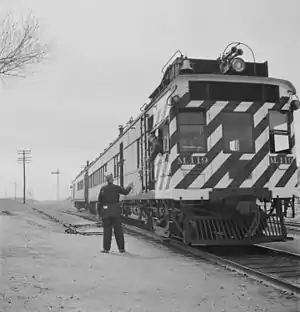34°54′25″N 106°41′53″W / 34.907°N 106.698°W
Isleta | ||||||||||||||||
|---|---|---|---|---|---|---|---|---|---|---|---|---|---|---|---|---|
| Former ATSF passenger rail station | ||||||||||||||||
 A "doodlebug" at Isleta in 1943 | ||||||||||||||||
| General information | ||||||||||||||||
| Location | Trackside Isleta Village Proper, New Mexico | |||||||||||||||
| Owned by | Atchison, Topeka and Santa Fe Railway (– 1996) BNSF Railway (1996 –) | |||||||||||||||
| Tracks | 2 | |||||||||||||||
| Construction | ||||||||||||||||
| Structure type | at-grade | |||||||||||||||
| Former services | ||||||||||||||||
| ||||||||||||||||
Isleta Station was a railway station on the Atchison, Topeka and Santa Fe Railway in Isleta, New Mexico. Located 12 miles (19 km) south of Albuquerque,[1][2] Isleta was a junction station, located at the point where two lines split. One line went to El Paso, Texas, while the other was the main line to Los Angeles.[3] The Southwest Chief passenger train now passes by on the Los Angeles line.
History
Isleta was at the eastern end of the Atlantic and Pacific Railroad (A&P), which was partly owned by the Santa Fe and partly owned by the Frisco Lines. Operated by both railroads, construction started in 1880 and continued 75 miles west until summer 1883 when it met arch rivel Southern Pacific at Needles, California.[4][5] This line between Needles and Mojave was built by SP for the single purpose of stopping the Santa Fe from getting to California.[6][5] The A&P was originally planned to head west out of Albuquerque, which would have bypassed Isleta. This route was abandoned because of many steep grades and a heavier cost of construction.[1][7]
In 1890, the Santa Fe gained full control of the Frisco and sold the Western division (Isleta – Needles) to the Santa Fe subsidiary Santa Fe Pacific Railroad. They merged with Frisco successor Burlington Northern to form the BNSF Railway. It is now a part of the Southern Transcon.
References
- 1 2 Bryant Jr., Keith L. (1974). History of the Atchison, Topeka and Santa Fe Railway. New York City: Macmillan Publishing Company. pp. 86–87. ISBN 0-02-517920-9.
- ↑ Bradley, Glenn Danford (1920). "An Outlet to the Pacific". The story of the Santa Fe. Boston: The Gorham Press. p. 220.
The work had started at Isleta, a point twelve miles below Albuquerque, where the Santa Fe main line crosses the Rio Grande.
- ↑ Prince, L. Bradford. Spanish mission churches of New Mexico. Cedar Rapids, Iowa: The Torch Press. p. 190. Archived from the original on 2011-05-17. Retrieved 2011-04-28.
- ↑ Glischinski, Steve (1997). Santa Fe Railway. Osceola, WI: Motorbooks International. p. 18. ISBN 978-0-7603-0380-1.
- 1 2 Waters 1950, p. 69
- ↑ Marshall, James. "Unlocking an Empire". Santa Fe: The Railroad that Built an Empire. New York City: Random House. p. 170.
- ↑ Waters, L. L. (1950). "Branching Out". Steel Trails to Santa Fe. Lawrence, Kansas: University of Kansas Press. p. 68.